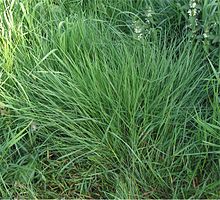|
Agrostis
Agrostis (bent or bentgrass) is a large and very nearly cosmopolitan genus of plants in the grass family, found in nearly all the countries in the world.[4][5][6][7][8][9] It has been bred as a GMO creeping bent grass.[10] SpeciesAs of May 2024[update], Plants of the World Online accepted the following species:[11]
Hundreds of species formerly listed in the genus Agrostis have been moved to other genera, including Achnatherum, Aira, Alloteropsis, Apera, Arundinella, Calamagrostis, Chionochloa, Chloris, Cinna, Colpodium, Crypsis, Cynodon, Deschampsia, Dichelachne, Digitaria, Eremochloa, Eriochloa, Eustachys, Gastridium, Graphephorum, Gymnopogon, Lachnagrostis, Leptochloa, Muhlenbergia, Pentameris, Phippsia, Piptatherum, Poa, Polypogon, Puccinellia, Reimarochloa, Relchela, Schismus, Sporobolus and Zingeria.[3] Former species include:
UsesSome species of bents are commonly used for lawn grass. This is a desirable grass for golf course teeing areas, fairways, and greens. Bentgrass is used in turf applications for its numerous advantages: it can be mowed to a very short length without damage, it can handle a great amount of foot traffic, it has a shallow root system that is thick and dense allowing it to be seeded and grow rather easily, and it has a pleasing, deep green appearance. The name "bent" refers to the shallow roots, which bend just below the surface of the soil to propagate laterally.[citation needed] Creeping bentAgrostis stolonifera is the most commonly used species of Agrostis. Historically, it was often called Orcheston long grass, after a village on Salisbury Plain, England. It is cultivated almost exclusively on golf courses, especially on putting greens. Creeping bent aggressively produces horizontal stems, called stolons, that run along the soil's surface. These allow creeping bent to form dense stands under conducive conditions and outcompete bunch-type grass and broadleaf weeds. As such, if infested in a home lawn, it can become a troublesome weed problem. The leaves of the bentgrass are long and slender.[citation needed] It can quickly take over a home lawn if it is not controlled and has very shallow roots.[12] The Scotts Miracle-Gro Company and Monsanto genetically engineered creeping bent to be glyphosate-tolerant under Monsanto's Roundup Ready trademark,[13] as "one of the first wind-pollinated, perennial, and highly outcrossing transgenic crops". In 2003, Scotts planted it as part of a large (about 160 ha) field trial in central Oregon near Madras. In 2004, its pollen was found to have reached wild growing bentgrass populations up to 14 kilometres away. Cross-pollinating Agrostis gigantea was even found at a distance of 21 kilometres.[10] Scotts could not remove all genetically engineered plants and in 2007, the Animal and Plant Health Inspection Service fined them $500,000 for non-compliance with Plant Protection Act regulations.[14] Common bentAgrostis capillaris, or colonial bent, was brought to America from Europe. This was the type of grass that was used on the lawns of most estates. It is the tallest of the bents with very fine texture and like most bent grasses grows very densely. Although this species has been used on golf courses and sporting fields it is better suited for lawns. Colonial bent is fairly easy to grow from seeds and fertilization of the lawn is not as intense. This grass also takes longer to establish than creeping bent. However it does not require the intense maintenance.[citation needed] Velvet bentAgrostis canina gets its name for the velvet appearance that this grass produces. It has the finest texture of all the bent grasses. This grass was used in Europe for estate lawns and golf courses because it could be cut so short. Velvet bent grass requires similar upkeep and maintenance to creeping bent. Velvet bent has recently had a resurgence in the UK due to the high demands on greens from inclement weather and speed expectations. This species also has a lighter color than the two previous species.[15] Butterfly food plantButterflies whose caterpillars feed on Agrostis include:
See alsoReferences
External links |
||||||||||||||||||||||||||||||||||||||||
